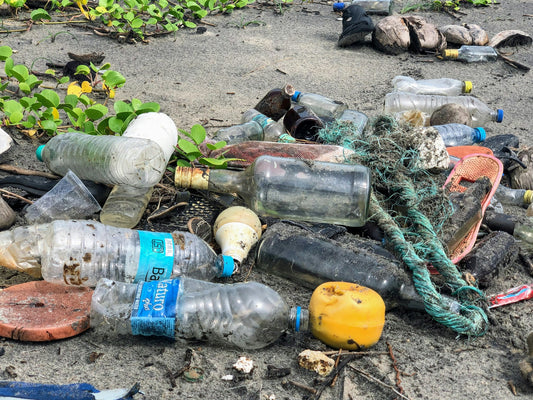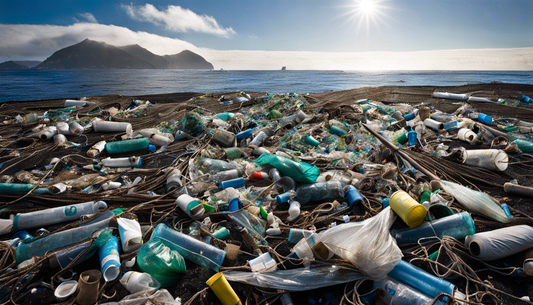Share
It's 2025, and we're still talking about those pesky PFAS forever chemicals.
They now even have taken up permanent residence in our bodies.
99% of adults have PFAS in their bloodstream.
We're here to talk about what PFAS are, why they’re a big deal, and most importantly, how to kick them out of your system.
Let's dive in and learn how to say goodbye to forever chemicals.
What's the Deal with Forever Chemicals?
First of all, let's get some confusion out of the way. When you read 'forever chemicals' or 'PFAS', most of the times, people mean the same.
Per- and polyfluoroalkyl substances (PFAS) are a group of synthetic chemicals that have been used in many consumer products around the world since the 1950s.
The main reason for their success has been their water- and grease resistant properties. Hence PFAS have been added to products like non-stick pans, water resistant textiles, or even easy-gliding dental floss.
You will sometimes read about PFOA (Perfluorooctanoic acid) or PFOS (perfluorooctanesulfonic acid), which are specific chemicals under the PFAS family. After all, more than 10,000 specific chemicals fall under the group of PFAS.
So why are those tongue twisters called forever chemicals? Well, because they last almost forever.
For the hobby chemists under us, what that means is that PFAS molecules have a very strong bond between fluorine and carbon atoms.
This bond is very hard to break in the natural environment, which is why PFAS can take more than 1000 years to degrade.
Why Should You Care About Forever Chemicals?

Because forever chemicals have been used in many consumer products for decades (and still are), we are constantly exposed to them. In fact, studies found that the chemicals can be found in the bloodstream of 99% of adults.
Now that wouldn't be a problem, if forever chemicals were harmless. But unfortunately that's not the case. PFAS have been linked to a whole plethora of health conditions.
The US National Cancer Institute has issued an official warning and researches PFAS extensively. The Institute has been able to find a direct link between PFAS exposure and at least 7 types of cancer.
But it doesn't stop there. The National Health Institute warns that PFAS can lead to a "variety of health effects, including altered immune and thyroid function, liver disease, lipid and insulin dysregulation, kidney disease, adverse reproductive and developmental outcomes[...]"
How Do You Get PFAS Out of Your Body?
While there is no silver bullet against forever chemicals, there are a few things you can do to help your body's natural ability to remove toxins from your system.
1. Avoid Exposure

"C'mon, I wanna how how to get rid of those nasty chemicals in my body and you tell me to avoid exposure?"....
We hear you! Nonetheless, we are starting with the most obvious point, because everything we talk about below will be more effective if you limit your exposure to forever chemicals in the first place.
Unfortunately, PFAS are everywhere, from firefighting foam to non-stick cookware. The news have reported on many scandals from PFAS in drinking water supplies, to crops fertilizer, to firefighting foam.
Here are some easy tips that reduce your risk to being exposed to forever chemicals:
- Avoid non-stick foodware like teflon pans
- Limit use of take out food packaging
- Filter your water directly from the tap with PFAS-certified filters
- Avoid long exposure to water resistant textiles like rain coats
- Choose natural products wherever you can
- Do your research before buying a product and look for ingredients like 'fluoro' or 'perfluoro'
- Educate yourself about toxins in your household
After all, by reading this article, you are already on the right track to educate yourself and remove forever chemicals from your life.
2. Probiotics Power

Chemicals research shows that probiotics are a potential super star in the fight against forever chemicals in your body.
Probiotics are "good" bacteria that are naturally present in your body, especially in your digestive system, and play a crucial role in maintaining overall health.
Consumed in adequate amounts, probiotics offer a variety of health benefits and have been linked to immune benefits, heart health and are particularly beneficial for gut health.
Studies show that probiotics are able to bind various toxic chemicals, including PFAS. They can decrease the absorption of chemicals in the intestine and transport them right out the back door.
You can obtain probiotics from various sources:
- Fermented foods like yogurt, kefir, kimchi, and miso
- Dietary supplements
- Certain foods fortified with probiotics
While more research is needed for exact effects and dosages of probiotics in the context of forever chemicals, mixing in a few probiotics here and there can be a good start to improve your gut health and improve your body's ability to fight chemicals.
3. Fiber Fighter

In a similar vein, a high fiber diet may be beneficial in getting those nasty chemicals out of your body. The National Institute of Environmental Health Sciences finds that "[...] diets rich in fiber can counteract the adverse health effects of environmental pollutants."
The referenced study further shows that soluble fibers like pectin and inulin can help limit the effects induced by PFAS, increase the bodily ability to excrete them, and support a healthy gut.
To boost your intake of soluble fiber like pectin and inulin, you can incorporate a variety of delicious and nutritious foods into your diet. Here are some sources:
Pectin-rich Foods
- Apples: A medium apple contains about 1 gram of soluble fiber
- Citrus fruits: Oranges and grapefruits provide about 2 grams of soluble fiber per medium-sized fruit
- Berries: Blackberries offer about 1 gram of soluble fiber per half cup
- Pears: A medium pear provides about 2 grams of soluble fiber
Inulin-rich foods:
- Onions: Half a cup of cooked onions contains about 1 gram of soluble fiber
- Asparagus: This vegetable is a good source of inulin
- Bananas: A medium banana provides about 1 gram of soluble fiber
Other Excellent Sources of Soluble Fiber:
- Oats: One cup of cooked oatmeal contains about 2 grams of soluble fiber
- Psyllium husk: one tablespoon has around 5-6 grams of soluble fiber
- Flax seeds: one tablespoon has around 5-6 grams of soluble fiber
- Brussels sprouts: Half a cup of cooked Brussels sprouts offers 2 grams of soluble fiber
Remember to increase your fiber intake gradually and drink plenty of water to avoid digestive discomfort. Aim for 5-10 grams of soluble fiber per day, or follow your dietitian's recommendations.
4. Lower Your Cholesterol

Studies show that increased PFAS level are correlated with increased cholesterol. While it is an open question if one leads to the other, it is a good idea to balance your cholesterol to help your liver do its job.
- Embrace heart-healthy fats: Replace saturated fats with polyunsaturated and monounsaturated fats found in olive oil, nuts, avocados, and fatty fish. These good fats can help lower LDL "bad cholesterol" levels
- Eat more fruits and vegetables: They provide essential vitamins, minerals, and fiber while being low in saturated fat
- Include plant sterols and stanols: Found in whole grains, nuts, and some fortified foods, these compounds block cholesterol absorption in the body
- Exercise regularly and maintain a normal body weight
- Limit alcohol consumption
- Quit smoking
While lowering your cholesterol has many benefits, it mainly helps maintain a healthy cardiovascular system and a healthy liver. The liver is the largest gland in the body and one of its main functions is to detoxify the body
5. Stay Hydrated

Will staying hydrated immediately flush PFAS out of your body? No! But as with some of the tips above, staying hydrated helps your body use its natural detox magic to slowly get rid of unwanted toxins.
It is recommended to drink:
- Women: 11.5 cups = 92 ounces = around 2.7 liters
- Men: 15.5 cups = 124 ounces = around 3.6 liters
That includes all fluids and also around 20% fluid intake that usually comes from food.
This fluid intake obviously depends on heat and your physical activity. It is a good idea to listen to your body. Also, try to drink water and avoid soft drinks or alcohol.
6. A Healthy Body Over Magical Claims
Finally, please stay vigilant about claims that just seem too good to be true. We have issued this warning as well for our tips about getting rid of microplastics in your body. There is no magic recipe for detoxifying PFAS.
You will find many supplements online that claim they found a silver bullet against PFAS. Before believing these claims, please do your research and look for certifications.
Some providers of activated charcoal supplements for example have received warnings by the FDA for false claims.
The most effective weapon against PFAS is avoiding them in the first place and doing what you can to help your bodies' natural detox function.
The Future is PFAS Free
While we can't completely eliminate PFAS from our lives (yet), we can certainly reduce our exposure. Scientists are working hard to find new ways to break down these stubborn chemicals
Who knows? In the near, future we might be throwing PFAS farewell parties! Remember, detoxing from PFAS is more of a marathon than a sprint. But with these easy tips, you'll be on your way to a healthier, happier you.
So, put on your favorite tunes, dance around your kitchen while making that probiotic-rich, fiber-rich, cholesterol-lowering smoothie, and show those forever chemicals who's boss!
We hope you enjoyed this article. If you want to read more like this, make sure to check out our Blog and follow us on Instagram. If you are interested in truly sustainable products, check out our Shop.
If you want to engage in the discussion, feel free to leave a comment below.








